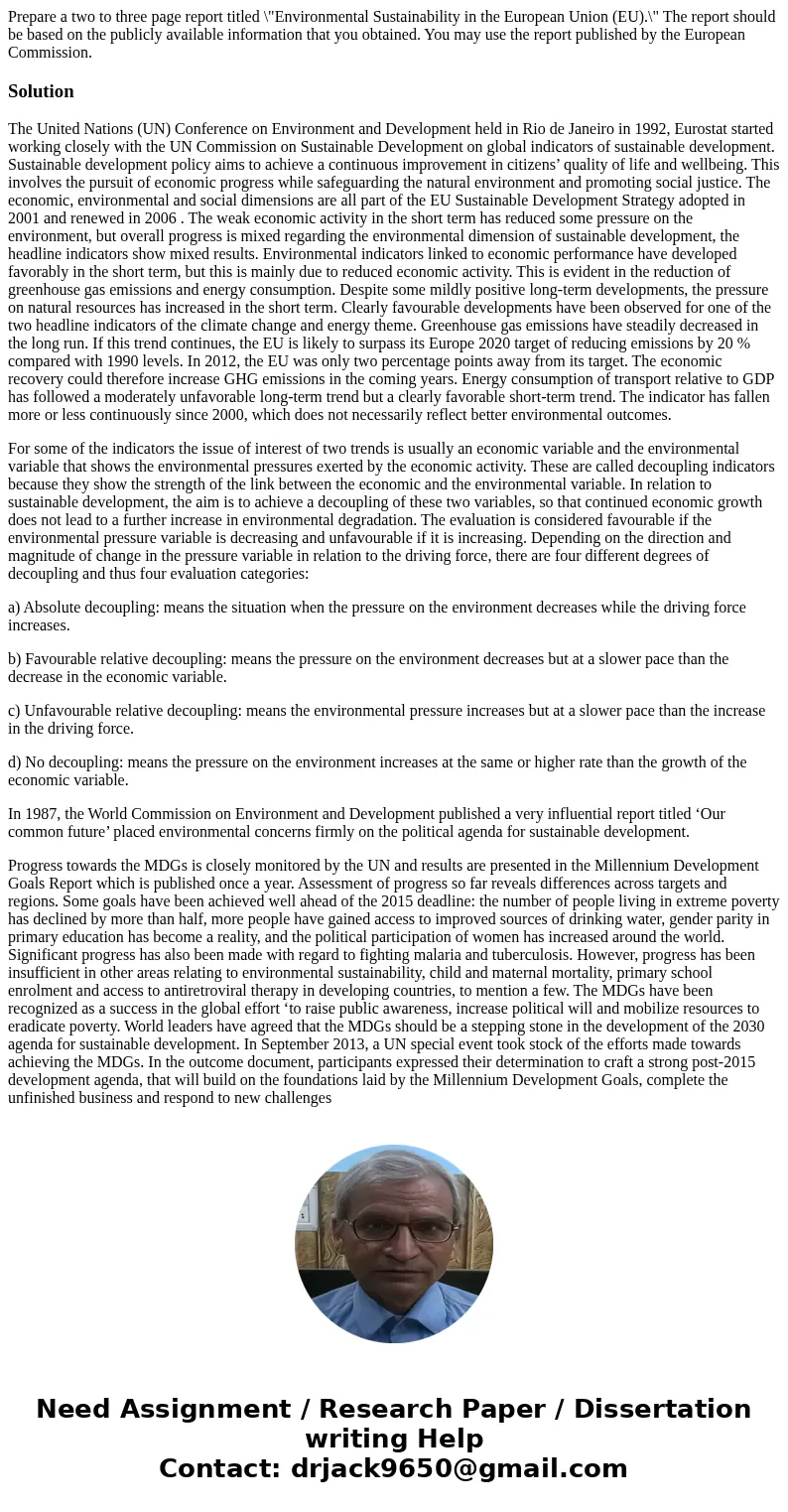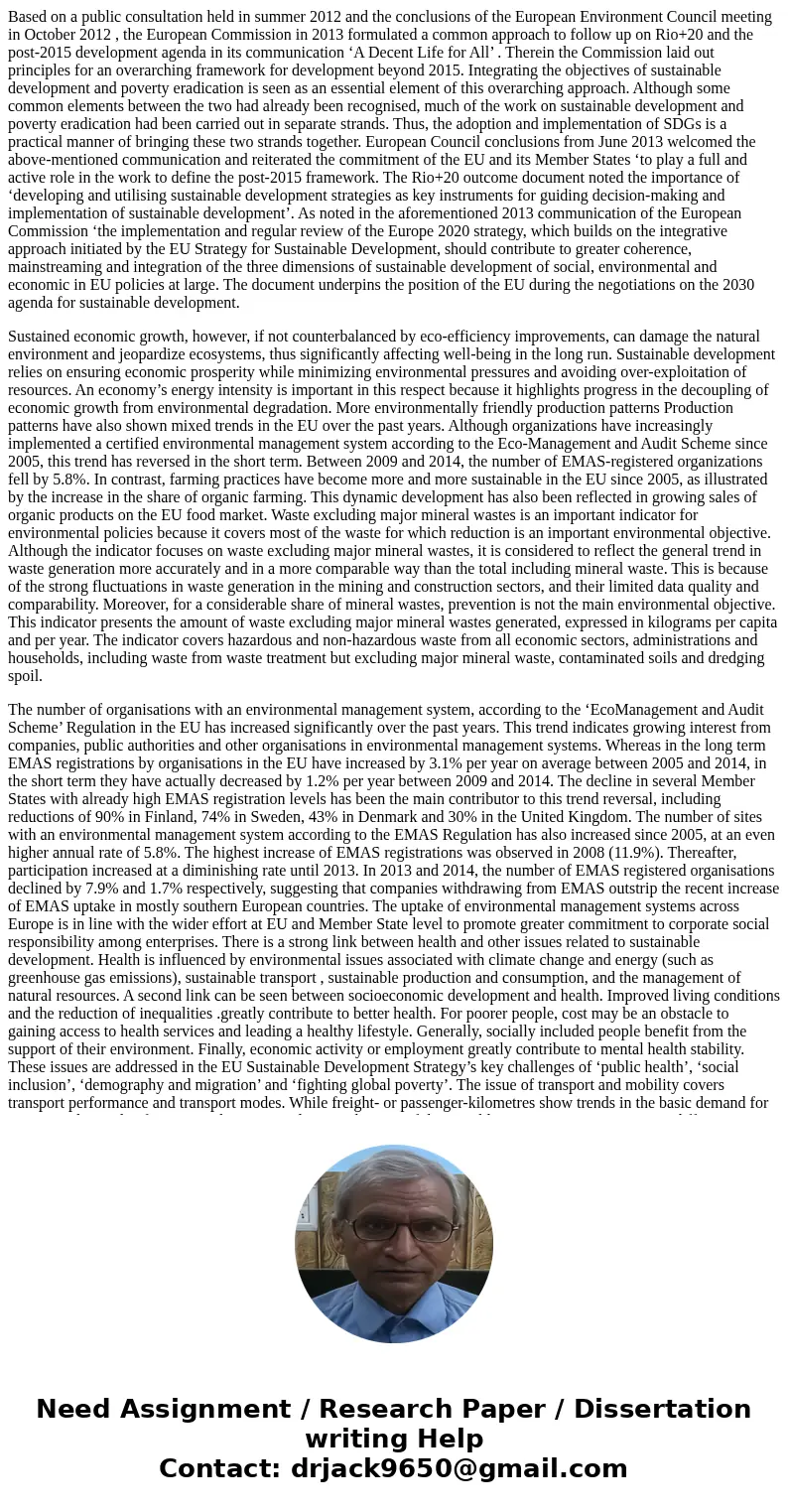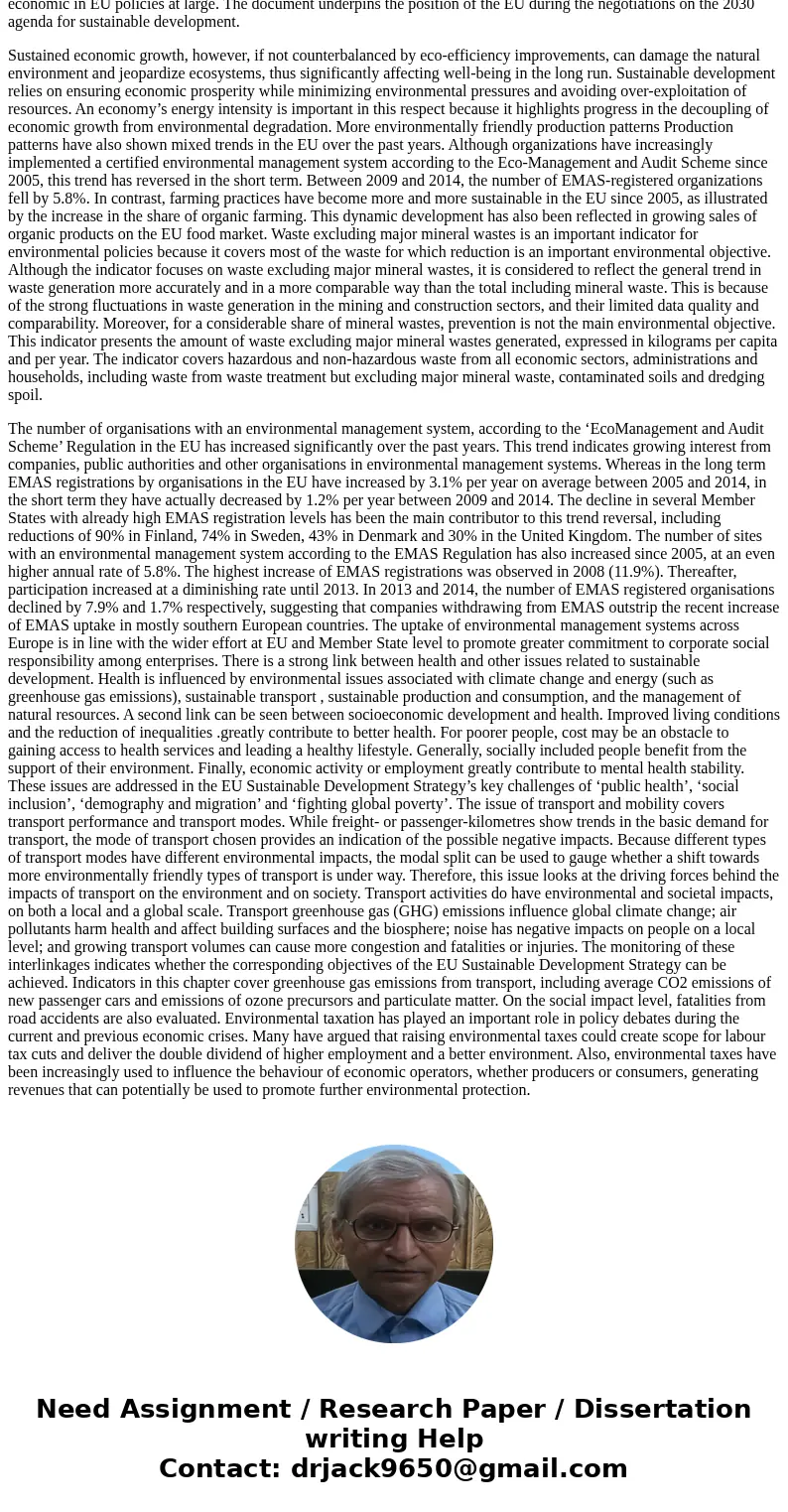Prepare a two to three page report titled Environmental Sust
Prepare a two to three page report titled \"Environmental Sustainability in the European Union (EU).\" The report should be based on the publicly available information that you obtained. You may use the report published by the European Commission.
Solution
The United Nations (UN) Conference on Environment and Development held in Rio de Janeiro in 1992, Eurostat started working closely with the UN Commission on Sustainable Development on global indicators of sustainable development. Sustainable development policy aims to achieve a continuous improvement in citizens’ quality of life and wellbeing. This involves the pursuit of economic progress while safeguarding the natural environment and promoting social justice. The economic, environmental and social dimensions are all part of the EU Sustainable Development Strategy adopted in 2001 and renewed in 2006 . The weak economic activity in the short term has reduced some pressure on the environment, but overall progress is mixed regarding the environmental dimension of sustainable development, the headline indicators show mixed results. Environmental indicators linked to economic performance have developed favorably in the short term, but this is mainly due to reduced economic activity. This is evident in the reduction of greenhouse gas emissions and energy consumption. Despite some mildly positive long-term developments, the pressure on natural resources has increased in the short term. Clearly favourable developments have been observed for one of the two headline indicators of the climate change and energy theme. Greenhouse gas emissions have steadily decreased in the long run. If this trend continues, the EU is likely to surpass its Europe 2020 target of reducing emissions by 20 % compared with 1990 levels. In 2012, the EU was only two percentage points away from its target. The economic recovery could therefore increase GHG emissions in the coming years. Energy consumption of transport relative to GDP has followed a moderately unfavorable long-term trend but a clearly favorable short-term trend. The indicator has fallen more or less continuously since 2000, which does not necessarily reflect better environmental outcomes.
For some of the indicators the issue of interest of two trends is usually an economic variable and the environmental variable that shows the environmental pressures exerted by the economic activity. These are called decoupling indicators because they show the strength of the link between the economic and the environmental variable. In relation to sustainable development, the aim is to achieve a decoupling of these two variables, so that continued economic growth does not lead to a further increase in environmental degradation. The evaluation is considered favourable if the environmental pressure variable is decreasing and unfavourable if it is increasing. Depending on the direction and magnitude of change in the pressure variable in relation to the driving force, there are four different degrees of decoupling and thus four evaluation categories:
a) Absolute decoupling: means the situation when the pressure on the environment decreases while the driving force increases.
b) Favourable relative decoupling: means the pressure on the environment decreases but at a slower pace than the decrease in the economic variable.
c) Unfavourable relative decoupling: means the environmental pressure increases but at a slower pace than the increase in the driving force.
d) No decoupling: means the pressure on the environment increases at the same or higher rate than the growth of the economic variable.
In 1987, the World Commission on Environment and Development published a very influential report titled ‘Our common future’ placed environmental concerns firmly on the political agenda for sustainable development.
Progress towards the MDGs is closely monitored by the UN and results are presented in the Millennium Development Goals Report which is published once a year. Assessment of progress so far reveals differences across targets and regions. Some goals have been achieved well ahead of the 2015 deadline: the number of people living in extreme poverty has declined by more than half, more people have gained access to improved sources of drinking water, gender parity in primary education has become a reality, and the political participation of women has increased around the world. Significant progress has also been made with regard to fighting malaria and tuberculosis. However, progress has been insufficient in other areas relating to environmental sustainability, child and maternal mortality, primary school enrolment and access to antiretroviral therapy in developing countries, to mention a few. The MDGs have been recognized as a success in the global effort ‘to raise public awareness, increase political will and mobilize resources to eradicate poverty. World leaders have agreed that the MDGs should be a stepping stone in the development of the 2030 agenda for sustainable development. In September 2013, a UN special event took stock of the efforts made towards achieving the MDGs. In the outcome document, participants expressed their determination to craft a strong post-2015 development agenda, that will build on the foundations laid by the Millennium Development Goals, complete the unfinished business and respond to new challenges
Based on a public consultation held in summer 2012 and the conclusions of the European Environment Council meeting in October 2012 , the European Commission in 2013 formulated a common approach to follow up on Rio+20 and the post-2015 development agenda in its communication ‘A Decent Life for All’ . Therein the Commission laid out principles for an overarching framework for development beyond 2015. Integrating the objectives of sustainable development and poverty eradication is seen as an essential element of this overarching approach. Although some common elements between the two had already been recognised, much of the work on sustainable development and poverty eradication had been carried out in separate strands. Thus, the adoption and implementation of SDGs is a practical manner of bringing these two strands together. European Council conclusions from June 2013 welcomed the above-mentioned communication and reiterated the commitment of the EU and its Member States ‘to play a full and active role in the work to define the post-2015 framework. The Rio+20 outcome document noted the importance of ‘developing and utilising sustainable development strategies as key instruments for guiding decision-making and implementation of sustainable development’. As noted in the aforementioned 2013 communication of the European Commission ‘the implementation and regular review of the Europe 2020 strategy, which builds on the integrative approach initiated by the EU Strategy for Sustainable Development, should contribute to greater coherence, mainstreaming and integration of the three dimensions of sustainable development of social, environmental and economic in EU policies at large. The document underpins the position of the EU during the negotiations on the 2030 agenda for sustainable development.
Sustained economic growth, however, if not counterbalanced by eco-efficiency improvements, can damage the natural environment and jeopardize ecosystems, thus significantly affecting well-being in the long run. Sustainable development relies on ensuring economic prosperity while minimizing environmental pressures and avoiding over-exploitation of resources. An economy’s energy intensity is important in this respect because it highlights progress in the decoupling of economic growth from environmental degradation. More environmentally friendly production patterns Production patterns have also shown mixed trends in the EU over the past years. Although organizations have increasingly implemented a certified environmental management system according to the Eco-Management and Audit Scheme since 2005, this trend has reversed in the short term. Between 2009 and 2014, the number of EMAS-registered organizations fell by 5.8%. In contrast, farming practices have become more and more sustainable in the EU since 2005, as illustrated by the increase in the share of organic farming. This dynamic development has also been reflected in growing sales of organic products on the EU food market. Waste excluding major mineral wastes is an important indicator for environmental policies because it covers most of the waste for which reduction is an important environmental objective. Although the indicator focuses on waste excluding major mineral wastes, it is considered to reflect the general trend in waste generation more accurately and in a more comparable way than the total including mineral waste. This is because of the strong fluctuations in waste generation in the mining and construction sectors, and their limited data quality and comparability. Moreover, for a considerable share of mineral wastes, prevention is not the main environmental objective. This indicator presents the amount of waste excluding major mineral wastes generated, expressed in kilograms per capita and per year. The indicator covers hazardous and non-hazardous waste from all economic sectors, administrations and households, including waste from waste treatment but excluding major mineral waste, contaminated soils and dredging spoil.
The number of organisations with an environmental management system, according to the ‘EcoManagement and Audit Scheme’ Regulation in the EU has increased significantly over the past years. This trend indicates growing interest from companies, public authorities and other organisations in environmental management systems. Whereas in the long term EMAS registrations by organisations in the EU have increased by 3.1% per year on average between 2005 and 2014, in the short term they have actually decreased by 1.2% per year between 2009 and 2014. The decline in several Member States with already high EMAS registration levels has been the main contributor to this trend reversal, including reductions of 90% in Finland, 74% in Sweden, 43% in Denmark and 30% in the United Kingdom. The number of sites with an environmental management system according to the EMAS Regulation has also increased since 2005, at an even higher annual rate of 5.8%. The highest increase of EMAS registrations was observed in 2008 (11.9%). Thereafter, participation increased at a diminishing rate until 2013. In 2013 and 2014, the number of EMAS registered organisations declined by 7.9% and 1.7% respectively, suggesting that companies withdrawing from EMAS outstrip the recent increase of EMAS uptake in mostly southern European countries. The uptake of environmental management systems across Europe is in line with the wider effort at EU and Member State level to promote greater commitment to corporate social responsibility among enterprises. There is a strong link between health and other issues related to sustainable development. Health is influenced by environmental issues associated with climate change and energy (such as greenhouse gas emissions), sustainable transport , sustainable production and consumption, and the management of natural resources. A second link can be seen between socioeconomic development and health. Improved living conditions and the reduction of inequalities .greatly contribute to better health. For poorer people, cost may be an obstacle to gaining access to health services and leading a healthy lifestyle. Generally, socially included people benefit from the support of their environment. Finally, economic activity or employment greatly contribute to mental health stability. These issues are addressed in the EU Sustainable Development Strategy’s key challenges of ‘public health’, ‘social inclusion’, ‘demography and migration’ and ‘fighting global poverty’. The issue of transport and mobility covers transport performance and transport modes. While freight- or passenger-kilometres show trends in the basic demand for transport, the mode of transport chosen provides an indication of the possible negative impacts. Because different types of transport modes have different environmental impacts, the modal split can be used to gauge whether a shift towards more environmentally friendly types of transport is under way. Therefore, this issue looks at the driving forces behind the impacts of transport on the environment and on society. Transport activities do have environmental and societal impacts, on both a local and a global scale. Transport greenhouse gas (GHG) emissions influence global climate change; air pollutants harm health and affect building surfaces and the biosphere; noise has negative impacts on people on a local level; and growing transport volumes can cause more congestion and fatalities or injuries. The monitoring of these interlinkages indicates whether the corresponding objectives of the EU Sustainable Development Strategy can be achieved. Indicators in this chapter cover greenhouse gas emissions from transport, including average CO2 emissions of new passenger cars and emissions of ozone precursors and particulate matter. On the social impact level, fatalities from road accidents are also evaluated. Environmental taxation has played an important role in policy debates during the current and previous economic crises. Many have argued that raising environmental taxes could create scope for labour tax cuts and deliver the double dividend of higher employment and a better environment. Also, environmental taxes have been increasingly used to influence the behaviour of economic operators, whether producers or consumers, generating revenues that can potentially be used to promote further environmental protection.



 Homework Sourse
Homework Sourse